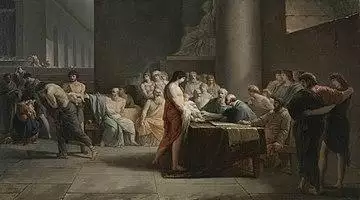
In ancient times, a method of infanticide or at least child abandonment was to leave infants in a wild place, either to die due to hypothermia, hunger, thirst, or animal attack,[1][2] or perhaps to be collected and brought up by those unable to produce their own children.
Modern scholars tend to see infant exposure as often a semi-official exchange mechanism, where one set of parents abandoned unwanted children, which were often picked up by other people wanting children, who lurked at the recognised spots for leaving children. Many ancient cities had recognised locations for this outside the city, which gave the chance of anonymity to those involved.
Mythological
This form of child abandonment is a recurring theme in mythology, especially among hero births.
Some examples include:
- Sargon, King of Agade – exposed to the river.
- Karna – exposed to the river.
- Tang Sanzang – exposed to the river on a wooden plank. The historical person he is based on never suffered such a fate.
- Oedipus – exposed in the mountains.
- Paris – exposed at the top of Mount Ida.
- Zāl – exposed in the Alborz mountains.
- Telephus – exposed on Mount Parthenion.
- Atalanta – exposed on Mount Parthenion.
- Perseus – boxed and cast into the sea with his mother, Danaë.
- Gilgamesh – thrown from the acropolis.
- Romulus and Remus – exposed in a tub to the Tiber River.
- Siegfried – exposed in a glass vessel to the river.
- Ken Arok, Javanese king – exposed to the river.
- Momotarō (桃太郎, "Peach Boy") – found inside of a giant peach, floating down a river.
Following the exposure, the infants are commonly reared by wild animals or adopted by lowly country folk, such as shepherds, before reaching maturity.
Sparta
According to Plutarch, in his Life of Lycurgus: "Offspring was not reared at the will of the father, but was taken and carried by him to a place called Lesche, where the elders of the tribes officially examined the infant, and if it was well-built and sturdy, they ordered the father to rear it, and assigned it one of the nine thousand lots of land; but if it was ill-born and deformed, they sent it to the so‑called Apothetae, a chasm-like place at the foot of Mount Taÿgetus, in the conviction that the life of that which nature had not well equipped at the very beginning for health and strength, was of no advantage either to itself or the state."[3]
However, this story has little other literary support, and modern excavations at the spot have found only adult human bones – it may have been used as a place of execution for criminals.
Interpretation
Otto Rank explores this topic in his book, The Myth of the Birth of the Hero. The exposure, especially in water, "signifies no more and no less than the symbolic expression of birth. The children come out of the water. The basket, box, or receptacle simply means the container, the womb; so that the exposure directly signifies the process of birth".
Further, according to Rank, these myths epitomize the natural psychological tension between parent and child. In all these stories there exists "a tendency to represent the parents as the first and most powerful opponents of the hero .... The vital peril, thus concealed in the representation of birth through exposure, actually exists in the process of birth itself. The overcoming of all these obstacles also expresses the idea that the future hero has actually overcome the greatest difficulties by virtue of his birth, for he has victoriously thwarted all attempts to prevent it."[4]
See also
References
- ^ Justin Martyr, First Apology.
- ^ Boswell, John Eastburn (1984). "Exposition and oblation: the abandonment of children and the ancient and medieval family". American Historical Review. 89 (1): 10–33. doi:10.2307/1855916. JSTOR 1855916. PMID 11611460.
- ^ Chapter 16
- ^ Rank, Otto. The Myth of the Birth of the Hero. Vintage Books: New York, 1932.